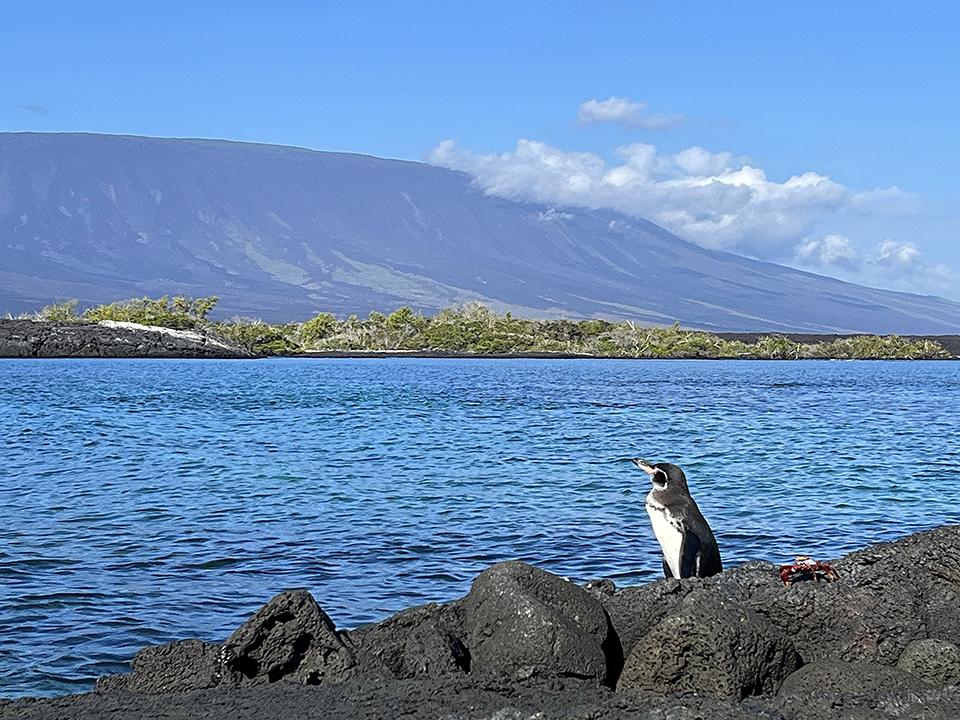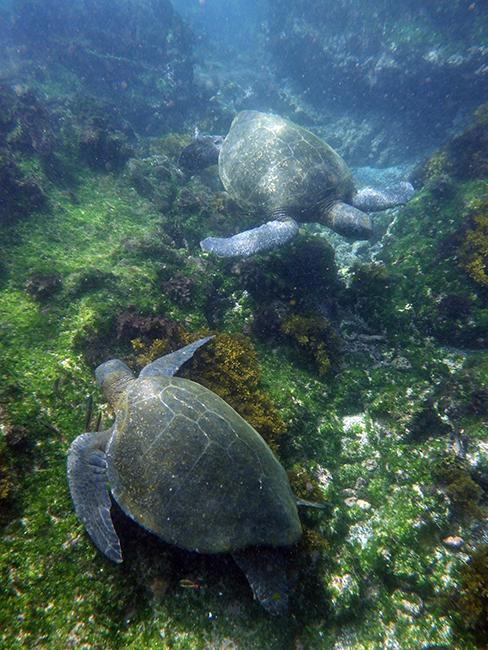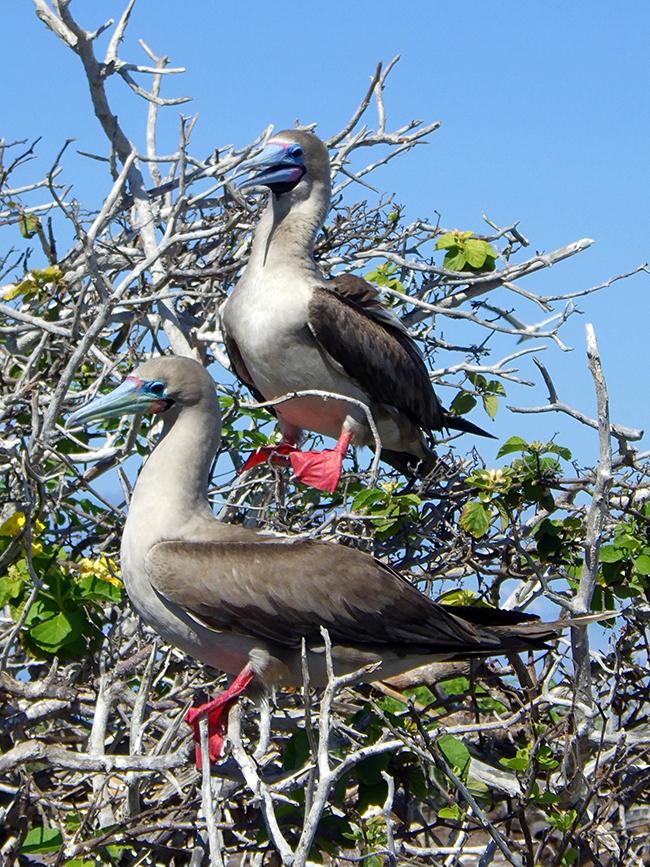
A blue-footed booby, Galapagos National Park / Kurt Repanshek
While North America hosts some spectacular national parks, other countries do, too. As a matter of fact, the Traveler’s Editor-in-Chief Kurt Repanshek traveled to Ecuador’s Galapagos National Park and viewed some stunning wildlife. So, it’s only right there should be a quiz and trivia piece centered on this national park. See how much you really know about the Galapagos Islands and its inhabitants before looking at the answers at the bottom of the page.
1. True or False: Galapagos Islands National Park is Ecuador’s second national park.
a) True
b) False
2. The blue-footed booby is one of ___ species of boobies found at Galapagos National Park.
a) three
b) four
c) five
d) six

Red-footed booby, Galapagos National Park / Kurt Repanshek
3. True or False: the red-footed booby is the largest of the three booby species found at Galapagos National Park.
a) True
b) False

What do you call a group of flamingos? Snazzy? Colorful? Galapagos National Park/Kurt Repanshek
4. A group of flamingos is called a / an ___
a) Ostentation
b) Flamboyance
c) Parliament
d) Venue

A marine iguana, Galapagos National Park / Kurt Repanshek
5. True or False: Marine iguanas sneeze salt.
a) True
b) False

I spy with my little eye a penguin on the rocks near the water, Galapagos National Park / Kurt Repanshek
6. True or False: Galapagos penguins are one of two species of penguin that live at or just above the equator.
a) True
b) False

Is that a smile I see on that land iguana? Galapagos National Park / Kurt Repanshek
7. There are ___ species of land iguanas endemic to Galapagos National Park.
a) Two
b) Three
c) Four

Domed tortoises, Galapagos National Park / Kurt Repanshek
8. According to galapagosconservancy.org, “Although there is a great amount of variation in size and shape among Galapagos tortoises, two main morphological forms exist — the domed carapace (similar to their ancestral form) and the ___ carapace.”
a) sway-backed
b) rectangular
c) oval
d) saddle-backed

If a sea turtle is in the water, can you tell if it's crying? Galapagos National Park / Kurt Repanshek
9. True or False: Galapagos green sea turtles cry tears to rid their system of excess salt.
a) True
b) False
10. According to nationalgeographic.com, “Galapagos National Park protects more than ___ square miles of islands and islets.”
a) 3,000
b) 4,000
c) 5,000
d) 6,000
Trivia

Land iguana, Galapagos National Park / Kurt Repanshek
“Land iguanas are large — more than 3 feet long — with males weighing up to 30 pounds. They live in the drier areas of the Islands, and in the mornings can be found sprawled beneath the hot equatorial sun. To escape the heat of the midday sun, they seek the shade of cacti, rocks, trees or other vegetation. At night they sleep in burrows dug in the ground, to conserve their body heat. They feed mainly on low-growing plants and shrubs, as well as fallen fruits and cactus pads. These succulent plants provide them with the moisture they require during long, dry periods. Land iguanas show a fascinating symbiotic interaction with Darwin’s finches, as do giant tortoises, raising themselves off the ground and allowing the little birds to remove ticks.”

Red-footed boobies, Galapagos National Park / Kurt Repanshek
“The Red-footed Booby is a graceful, slim-winged seabird named for its vivid coral-red feet which males show off during courtship. Most booby species nest on the ground, but the Red-footed nests in trees, so they don’t compete for nest sites. This habit also provides protection from ground predators, a welcome advantage for this smallest of the six booby species. Like other members of the family Sulidae, Red-footed Boobies pursue fish by diving into the sea, but also chase flying fish like a flycatcher chases flies … Red-footed boobies nest in trees, but only in sun and not in shaded areas … The oldest recorded red-footed booby was at least 22 years, 11 months old.”

A saddle-backed tortoise chowing down, Galapagos National Park / Kurt Repanshek
“Tortoises breed primarily during the hot season (January to May), though tortoises can be seen mating any month of the year. During the cool season (June to November), female tortoises migrate to nesting zones (generally in more arid areas) to lay their eggs. A female can lay from 1-4 nests over a nesting season (June to December). She digs the hole with her hind feet, then lets the eggs drop down into the nest, and finally covers it again with her hind feet. She never sees what she is doing. The number of eggs ranges from 2-7 for saddle-backed tortoises to sometimes more than 20-25 eggs for domed tortoises. The eggs incubate from 110 to 175 days (incubation periods depend on the month the nest was laid, with eggs laid early in the cool season requiring longer incubation periods than eggs laid at the end of the cool season when the majority of their incubation will occur at the start of the hot season). After hatching, the young hatchlings remain in the nest for a few weeks before emerging out a small hole adjacent to the nest cap. The sex of a tortoise is determined by the temperature of incubation, with females developing at slightly hotter temperatures.”
Quiz Answers
1b False
Galapagos National Park is Ecuador’s first national park. This country has a total of 11 national parks.
2a
The Galapagos Islands are home to three of the six species of boobies found in the world: blue-footed booby, red-footed booby, and Nazca booby.
3b False
The red-footed booby is the smallest of the booby species.
4b
A group of flamingos is known as a flamboyance of flamingos. The other group names: ostentation of peacocks, parliament of owls, venue of vultures.
5a True
Marine iguanas sneeze salt to get rid of excess salt in their system. That’s why you’ll often see a crust of white on their nose.
6b False
Galapagos penguins are the only species of penguins to live on the equator. The smallest South American penguin, they are endemic to the Galapagos Archipelago.
7b
There are three species of land iguana endemic to Galapagos National Park: Galapagos land iguana, Santa Fe land iguana, and pink land iguana.
8d
“Although there is a great amount of variation in size and shape among Galapagos tortoises, two main morphological forms exist — the domed carapace (similar to their ancestral form) and the saddle-backed carapace. Domed tortoises tend to be much larger in size and do not have the upward thrust to the front of their carapace; they live on the larger, higher islands with humid highlands where forage is generally abundant and easily available. Saddle-backed shells evolved on the arid islands in response to the lack of available food during drought. The front of the carapace angles upward, allowing the tortoise to extend its head higher to reach the higher vegetation, such as cactus pads.”
9a True
According to galapagosconservation.org.uk, “Galapagos green sea turtles are able to cry the excess salt in ‘tears’ from special glands underneath their eyes to keep a stable inner environment. They are fast swimmers, travelling at speeds up to 35 mph over long distances. They are even able to sleep underwater, but only for a few hours at a time. Stress affects the time they can spend underwater, so when fleeing a predator, they can only stay submerged for a shorter period of time. This also explains why turtles drown relatively quickly when they are caught in fishing nets.”
10a
“Galapagos National Park protects more than 3,000 square miles of islands and islets, while the Galápagos Marine Reserve protects an additional 50,000 square miles of ocean around the islands.”
References
https://abcbirds.org/bird/galapagos-penguin/
https://oceana.org/marine-life/marine-iguana/
https://www.nationalgeographic.com/animals/birds/facts/red-footed-booby
https://galapagosconservation.org.uk/wildlife/galapagos-green-turtle/
https://galapagosconservation.org.uk/wildlife/marine-iguana/

 Support Essential Coverage of Essential Places
Support Essential Coverage of Essential Places






